Who will be crowned king of New England's best-known pirates? Vote in the final round.
Editor's note: In honor of the Cape Cod Pirate Festival continuing at the Yarmouth Fairgrounds this weekend, we decided to drum up some swashbuckling competition between the Cape Cod pirates of yore. Starting Tuesday, we asked readers to vote for their favorite pirate in our first-ever Cape Cod Times Pirate Bracket. You'll find polls throughout this article. Each day the winning pirates will move on to the next round, while the losers will be sent to the brig. Keep checking back each day for your chance to vote. The winner will be announced Friday.
Pirates aren't the first characters who come to mind when thinking about New England. But historically, it turns out quite a few pirates made calls here, and some even called it home — including Cape Cod.
According to the New England Pirate Museum, Samuel "Black Sam" Bellamy, his one-time shipmate Blackbeard, and Captain Kidd were among some of the most well-known pirates who "roamed freely offshore plundering merchant ships."
"Like many of today's New Englanders, pirates spent their winters in the tropics and their summers here," the museum notes on its website, pointing out, too, that most 17th and 18th-century pirates were, in fact, New Englanders and New Yorkers who decided a pirate's life was for them.
"Pirates were welcomed visitors before the Revolution in areas such as Block Island, Rhode Island; Cape Cod and especially New York," said Daphne Palmer Geanacopoulos of South Yarmouth, an historian, journalist and author whose book "The Pirate's Wife: The Remarkable True Story of Sarah Kidd" delves into the region's pirate history.
"In 1695, the governor of New York, Benjamin Fletcher, encouraged pirates to come to Manhattan because they brought much needed currency — gold and silver coins called 'specie' — and exotic goods from far away places," she said.
Fletcher’s economic program, though, "was not viewed favorably by the British authorities," Geanacopoulos said, so he was replaced by "a law-and-order governor, Richard Coote, known as Lord Bellomont, who was tasked by the British authorities to stamp out piracy in the colonies."
Dennis resident Christopher Schultz, founder of the Cape Cod Pirate Festival who's also researched piracy, said there was an attraction to the freedom a pirate's life offered, and even today many people are drawn by pirate lore and the "romantic side" of pirate culture.
"I think it has a lot to do with the idea of the freedom and the sense of independence that comes with it," he said.
Here are a few of the historical pirates who were known here in New England.
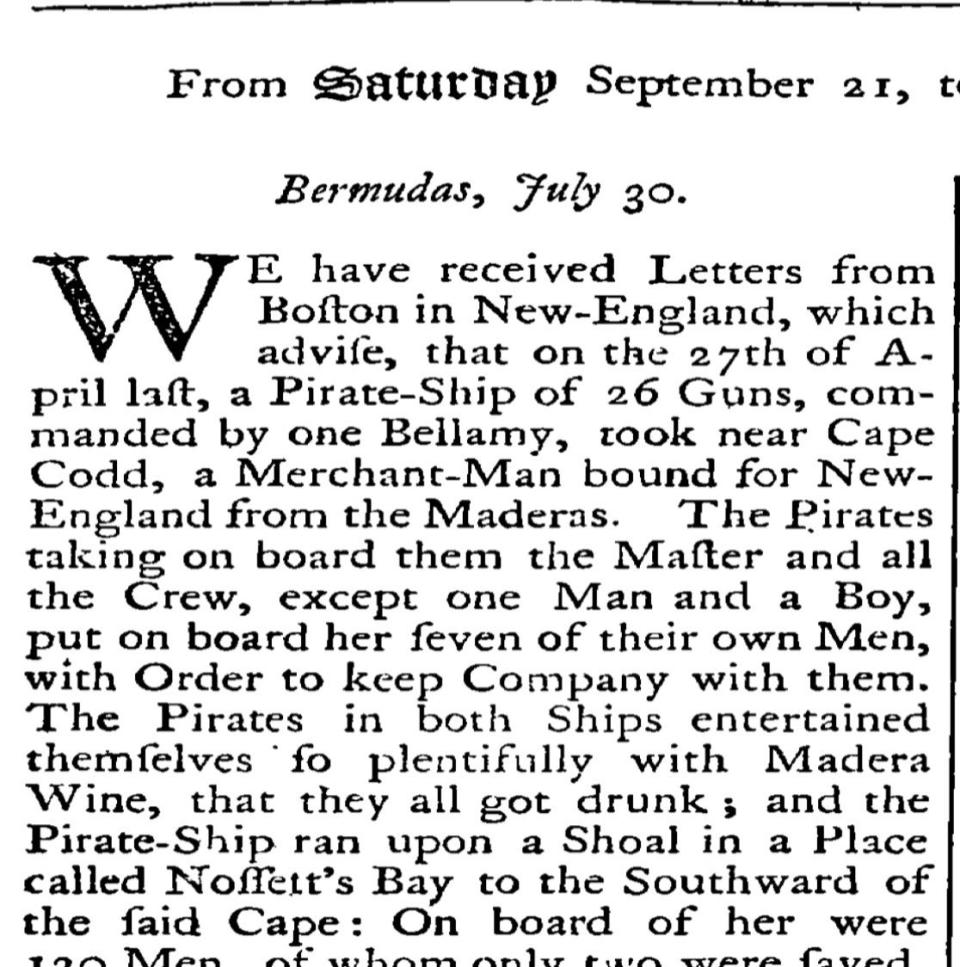
Samuel Bellamy
Aliases: Black Sam Bellamy, Black Bellamy, Robin Hood of the Sea, Prince of Pirates
DOB: c. Feb. 23, 1689
Place of birth: Devon, England
Death: April 26, 1717
Cause of death: Drowning in a shipwreck off Cape Cod
Flagship: Whydah Gally
Known for: Gallantry, fairness, being well dressed and groomed
Number of ships taken or plundered: At least 54
Modern worth of his loot: About $120 million
He wore his long, black hair neatly tied back with a black satin ribbon, and often selected an elegant black coat. For this reason, Samuel Bellamy was known as "Black Sam Bellamy," and he had a particular connection to Cape Cod.
Along with Paulsgrave Williams, a middle-aged man he befriended, Bellamy was one of the most famous pirates to ply the New England coast and Cape Cod, said Geanacopoulos. His flagship, the Whydah, wrecked off the coast of Wellfleet during a heavy storm in 1717, and Bellamy drowned.
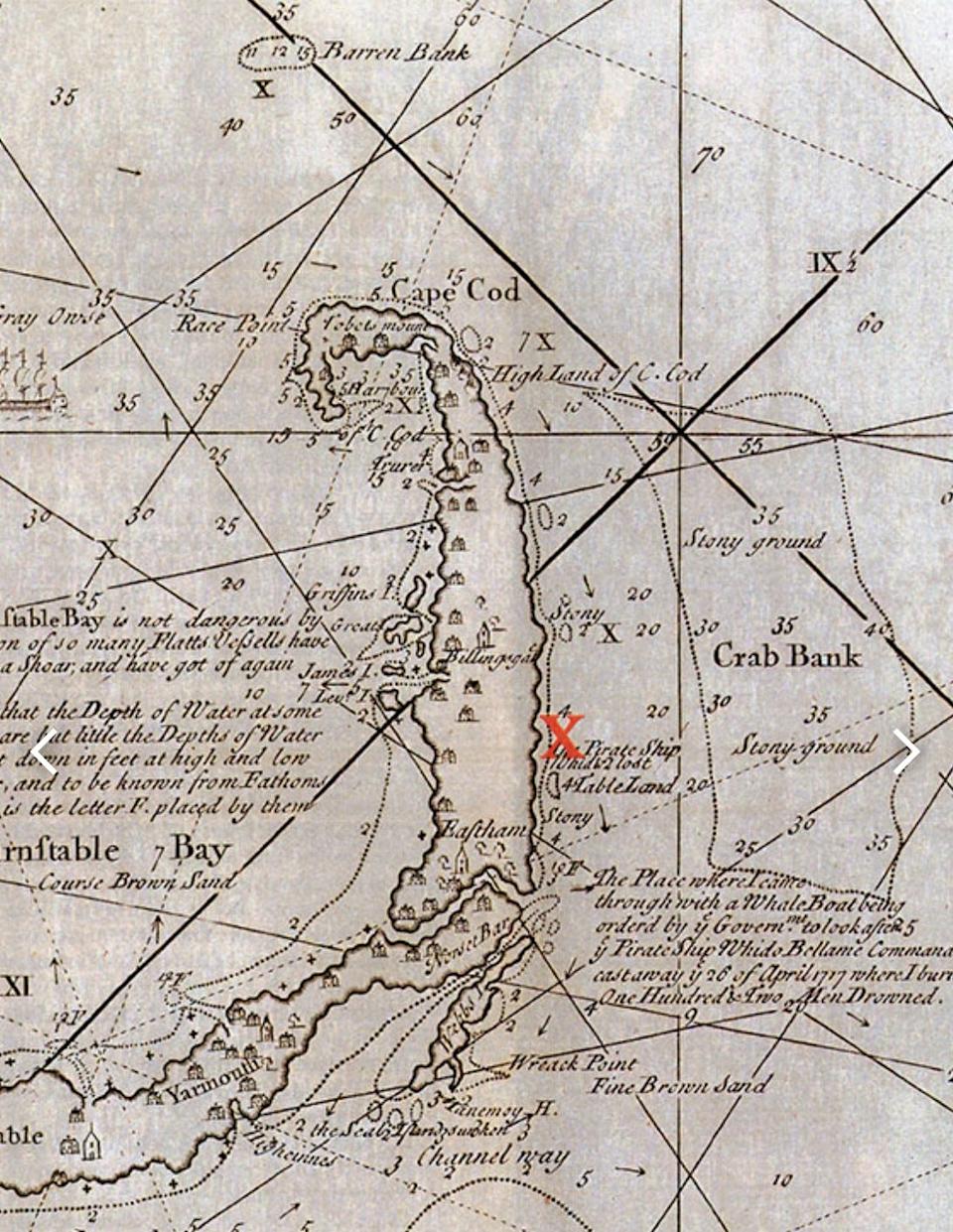
According to the NE Historical Society, he came to Cape Cod only about three years earlier, possibly to connect with relatives in Eastham. Cape lore says he fell in love with 15-year-old Mehitabel Hallett or Maria, and was eager to prove himself. After hearing about the Spanish treasure fleet's sinking in a hurricane off Florida in 1715, Bellamy headed south in hopes of salvaging some of the Spanish riches for himself. He was joined by Williams.
Unsuccessful in their quest, the duo instead joined privateer-turned-pirate Captain Benjamin Hornigold's crew in the West Indies. In 1716, Bellamy became a pirate captain when Hornigold gave him a captured ship.
From 1716-1717, Bellamy and his crew plundered at least 54 ships along the east coast and in the Caribbean. His last and greatest prize was the Whydah, a slave and trade ship carrying gold, rum, sugar, ivory and indigo back to Europe. Bellamy made the Whydah his flagship and turned toward Cape Cod, while Williams headed for Rhode Island to visit his family.
Schultz said Bellamy was notable for genteel manners, a democratic leadership style, and uniting a diverse crew.
"Bellamy was considered the prince of pirates," he said. "As long as you didn't put up any resistance, he'd just take your stuff and let you go."
The remains of the Whydah were found in 1984 by Barry Clifford of Brewster, Geanacopoulos said, "and over 200,000 artifacts have been recovered from the shipwreck" that spilled an estimated four tons of gold and silver. The artifacts are on display at the Whydah Pirate Museum on Route 28 in West Yarmouth.
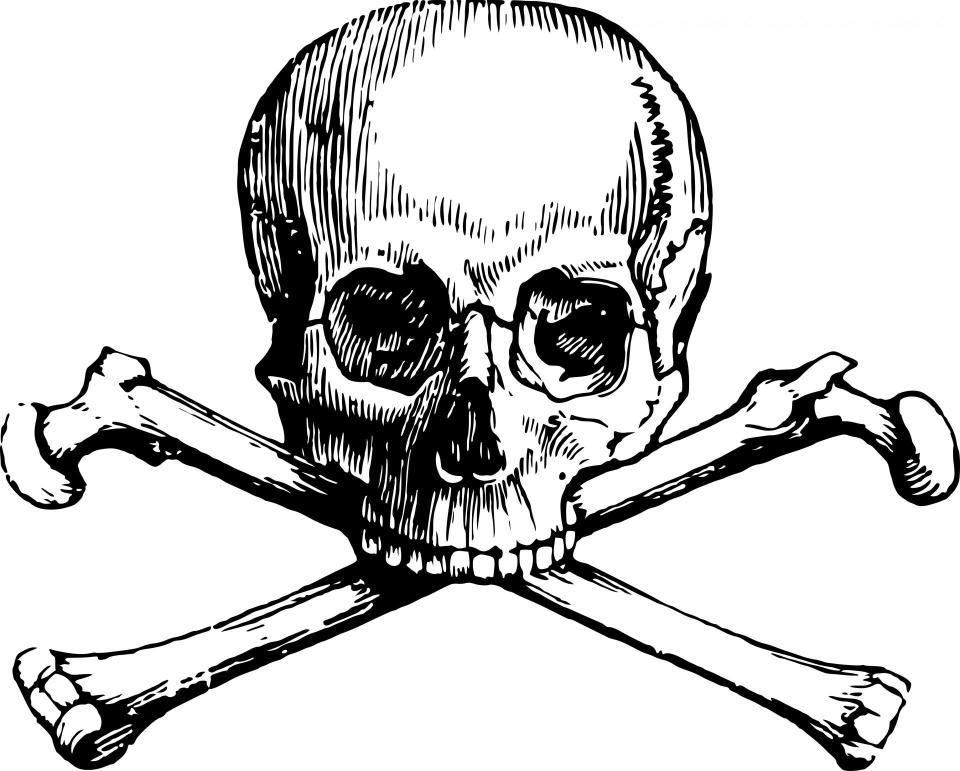
Paulsgrave Williams
Aliases: None
DOB: c. 1675
Place of birth: Newport, Rhode Island
Death: Unknown
Cause of death: Unknown
Flagship: Marianne
Known for: Sailing with Black Sam Bellamy
Number of ships taken or plundered: At least 54 ships (with Black Sam Bellamy)
Modern worth of his loot: About $120 million (shared with Black Sam Bellamy)
Paulsgrave Williams was best known for his association with Samuel "Black Sam" Bellamy, with whom he set out in 1715 in hopes of collecting salvage from the Spanish treasure fleet that sank in a hurricane off Florida. According to Geanacopoulos, he was a jeweler from Newport, Rhode Island with a wife and three children when he met Bellamy in Boston.
Unable to find any of the Spanish treasure, they turned to piracy in the Caribbean, eventually joining Captain Benjamin Hornigold. After Hornigold gave Bellamy command of one of their captured ships, Bellamy made Williams his quartermaster. Eventually, Hornigold was ousted and replaced by Bellamy, who gave Paulsgrave his own ship, the Marianne.
After taking the slave ship Whydah in 1717, the two headed back to New England. Paulsgrave sailed to Rhode Island, agreeing to meet up with Bellamy in Maine when he was done visiting his family.
After learning about the Whydah's loss in a storm off Cape Cod, and Bellamy's drowning, Paulsgrave sailed to the Bahamas, where he sold his ship and took a pardon King George was offering to pirates agreeing to surrender by September 1718.
Paulsgrave briefly returned to pirating off Africa with former comrades in 1720, but retired for good in 1723, when he remarried and began a new family.
Welcome to the brig. Here are the bracket results and historical pirates that will not be moving on to the next round.

Edward Low
Aliases: Ned Low
DOB: 1690
Place of birth: London, England
Death: Unknown
Cause of death: Unknown
Flagship: Various
Known for: Extreme cruelty
Number of ships taken or plundered: At least 100
Modern worth of his loot: $1.8 million
Ned Low, who settled in Boston in his 20s, was known for common thievery in his early life, according to World History Encyclopedia. Things looked briefly promising for him after he fell in love with and married Eliza Marble in Boston in 1714. The couple soon welcomed a son but lost him in infancy. Then Low lost his wife to childbirth in 1719. Their daughter survived, but Low was not interested and went to sea as a ship's rigger.
In 1722, Low and others attempted a mutiny and were put off their ship. A life of piracy ensued, as the men took a sloop off Rhode Island and proceeded to capture and plunder ships all along the coast. Low proved himself an exceptionally cruel pirate.
"Ned Low was horrible. He was what you think of when you think of a truly terrible pirate," said Schultz. "He was merciless. He cared nothing about hurting people because it gave him amusement."
During their reign of terror, Low and the others often traded smaller ships for larger ones. Low headed to the Caribbean and eventually the Azores. Emboldened by his successes, Low returned to the East Coast and attempted to take a British naval vessel off Long Island. The attempt was unsuccessful, but Low was not captured. He and his men embarked on a series of raids on whaling and fishing vessels off Nantucket and Rhode Island. Eventually they headed back to the Caribbean. Low increasingly turned his abuses on his crew and it is thought his men finally mutinied and marooned him on a deserted island sometime in 1724.
It is not known what became of Low, but there is at least one story about a French ship finding him and delivering him to his execution in Martinique.
William Kidd
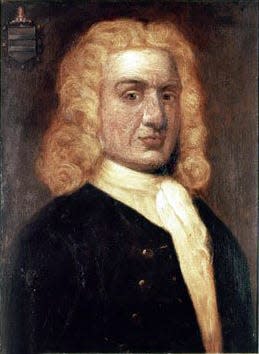
Aliases: Captain Kidd
DOB: c. 1645
Place of birth: Dundee, Scotland
Death: May 23, 1701
Cause of death: Hanging in London
Flagship: Blessed William
Known for: Fighting alongside his men, getting hanged twice
Number of ships taken or plundered: At least six
Modern worth of his loot: About $12.5 million
William Kidd, who was living in New York, started out as a privateer in 1689, sailing the East Coast and Caribbean. In 1691, he met and married a wealthy young widow, Sarah Bradley Cox Oort, in New York, with whom he had two daughters. He engaged in some legitimate dealings as a respected merchant and rubbed elbows with the social elite.
According to history.org, Kidd was commissioned in 1695 by Richard Coote, the Earl of Bellomont and newly appointed governor of Massachusetts Bay, New Hamsphire and New York, to hunt pirates and French ships in the Indian Ocean. At first, his efforts were unsuccessful, and by 1697 he began behaving more like a pirate, attacking Dutch and Portuguese vessels, too.
In 1698, he took the Quedah Merchant off the coast of India, a vessel that, with the end of the Nine Years' War, was no longer considered fair game under Kidd's privateering commission. The ship was richly laden with goods valued at about $2.5 million in today's money. Kidd was now officially viewed as a pirate.
Hoping to clear his name, he went to see his one-time supporter, Coote, in Boston in 1699. Kidd was arrested, charged with piracy, and imprisoned in Boston. A year later he was sent to England to stand trial and was found guilty. Kidd endured two hangings, the first one failing to kill him after the noose broke.
Before his arrest in Boston, it is said that Kidd took the time to bury his treasures.
"They believe some of his treasure was buried on one of the islands they leveled and then filled for Logan Airport," said Schultz, adding he's also heard some of the treasure may also have been buried on Cape Cod, among other locations.
Edward Teach

Aliases: Blackbeard
DOB: c. 1680
Place of birth: Uncertain, possibly Bristol, England
Death: Nov. 22, 1718
Cause of death: Multiple flintlock and cutlass wounds
Flagship: Queen Anne's Revenge
Known for: Fearsome appearance and manners, pillaging and burning ships, formidable fighter
Number of ships taken or plundered: At least 30
Modern worth of his loot: $12.5 million
Like Black Sam Bellamy, Edward Teach was a protégé of Captain Benjamin Hornigold, who taught them both "the ropes of pirating," said Schultz.
"Blackbeard was on Hornigold's ship with Bellamy," he said. "There couldn't be two more different pirates, ever."
While Bellamy cultivated a charming persona, Teach styled himself as someone to be dreaded. He was so successful with promoting this image and building a merciless reputation that fear of him alone was enough to get him what he wanted.
According to a description in Captain Charles Johnson's 1720s A General History of the Robberies and Murders of the Most Notorious Pyrates, Teach wore a thick black beard that grew up around his eyes and fell to his waist. Often his beard was braided and was tied with colorful ribbons, and he was said to put slow-burning fuses into it during engagements so that he appeared to be spewing smoke, conveying "such a figure that imagination cannot form an idea of a fury from hell to look more frightful."
Teach was killed during a battle with a British naval force at Ocracoke Island in North Carolina's Outer Banks.
Rachel (Schmidt) Wall
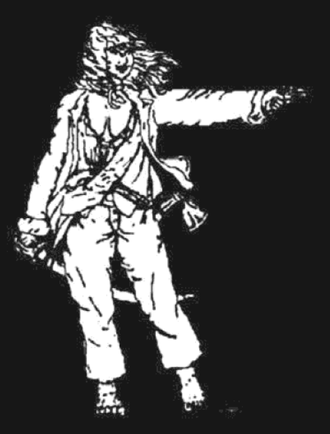
Alias: None
DOB: c. 1760
Place of birth: Carlisle, Pennsylvania
Death: Oct. 8, 1789
Cause of death: Hanging on Boston Common
Flagship: Essex
Known for: Playing the damsel in distress to lure victims, stealing from docked ships at night
Number of ships taken or plundered: At least 12
Modern worth of her loot: About $12,000
When she was 16, Rachel left home and headed to Philadelphia, where she fell in love with and married a fisherman and former privateer, George Wall. They eventually settled in Boston.
According to the New England Historical Society, Wall started out working as a maid while her husband went on fishing expeditions. After a long absence, he returned in 1781 and persuaded Rachel to join him and some others in robbing vessels in the Gulf of Maine.
Their tactic was to set their schooner adrift after storms and have Rachel on deck acting the damsel in distress, calling for help from passing vessels. When help came, the rest of the pirate crew would overtake and kill their victims, steal their goods and scuttle their vessels to make it appear they'd been lost in the storm.
After George Wall drowned in a storm in 1782, Rachel began stealing from ships anchored at Long Wharf in Boston Harbor, slipping aboard while the crew slept.
Her thievery ended in 1789 after she was accused of mugging a 17-year-old girl for her shoes, buckles and bonnet. For that she was tried for and convicted of highway robbery, and sentenced to hang. In her last words and dying confession, she admitted to acts of piracy and other crimes "too numerous to mention," but stressed she never murdered anyone and insisted, "as to the crime of Robbery, for which I am in a few hours to suffer an ignominious death. I am entirely innocent to the truth of this declaration."
She was the last woman to be executed by hanging in Massachusetts.
Thomas Pound

Aliases: None
DOB: Unknown
Place of birth: Probably England
Death: 1703
Cause of death: Unknown
Flagship: None
Known for: Deserting the Royal Navy to become a pirate, then later returning to the Navy with his own command
Number of ships taken or plundered: At least four
Modern worth of his loot: Unknown
Thomas Pound started out an officer in the Royal Navy stationed in Boston. In 1689, he joined other men in taking over a ship owned by Thomas Hawkins. For two months he and the others — including Hawkins — proceeded to attack vessels around New England, including off Cape Cod. They were captured in November off Naushon Island and later stood trial for piracy in Boston.
Pound and several others were sentenced to be hanged, but he and Hawkins had their sentences delayed when they were sent to England for their executions. On the way, the ship they were on was attacked by a French privateer. Pound was allowed to assist in the battle, and in the process earned a pardon, reinstatement of his naval rank, and eventually his own command. Hawkins was killed in the battle.
John Quelch
Aliases: Jack
DOB: 1666
Place of birth: London, England
Death: June 30, 1704
Cause of death: Hanging
Flagship: Charles
Known for: Going after Portuguese ships, which were friendly to England
Number of ships taken or plundered: At least nine
Modern worth of his loot: Unknown
John Quelch, also known as Jack, started out as a privateer but turned pirate after he joined in a mutiny with the crew of his ship, the Charles, and ousted their captain. Quelch was named the new captain and headed from his home base in Marblehead toward the Caribbean and South America, where he and his men attacked a number of Portuguese ships, according to the Massachusetts Historical Society.
Since Portugal was friendly with England, these actions were viewed as piracy, whereas Quelch was free to attack Spanish and French ships.
During their year of attacks, the pirates purloined many precious goods, from gold to sugar. In 1704, they returned to Massachusetts, and Quelch attempted to disguise his treasure as salvage from a Spanish shipwreck, but when Portuguese goods were found, his employers had him arrested. He and his crew were put on trial for piracy in Boston. Seven of the 20 were found guilty and were hanged.
Heather McCarron writes about climate change, environment, energy, science and the natural world, in addition to news and features in Barnstable, Brewster and Falmouth Reach her at hmccarron@capecodonline.com, or follow her on Twitter @HMcCarron_CCT
Editor's note: An earlier version of this article said the winner of the bracket would be announced Saturday. The winner will be announced Friday instead.
Thanks to our subscribers, who help make this coverage possible. If you are not a subscriber, please consider supporting quality local journalism with a Cape Cod Times subscription. Here are our subscription plans.
This article originally appeared on Cape Cod Times: Cape Cod, New England pirates: Kidd, Black Sam Bellamy, Rachel Wall

